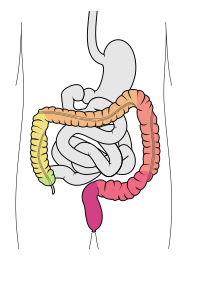
Photo from wikipedia
The gastrointestinal (GI) tract, particularly the colon region, holds a highly diverse microbial community that plays an important role in the metabolism, physiology, nutrition, and immune function of the host… Click to show full abstract
The gastrointestinal (GI) tract, particularly the colon region, holds a highly diverse microbial community that plays an important role in the metabolism, physiology, nutrition, and immune function of the host body. Accumulating evidence has revealed that alteration in these microbial communities is the pivotal step in developing various metabolic diseases, including obesity, inflammatory bowel disease (IBD), and colorectal cancer. However, there is still a lack of clear understanding of the interrelationship between microbiota and diet as well as the effectiveness of chemoprevention strategies, including pre and probiotic agents in modifying the colonic microbiota and preventing digestive diseases. Existing methods for assessing these microbiota-diet interactions are often based on samples collected from the feces or endoscopy techniques which are incapable of providing information on spatial variations of the gut microbiota or are considered invasive procedures. To address this need, here we have developed an electronic-free smart capsule that enables site-specific sampling of the gut microbiome within the proximal colon region of the GI tract. The 3D printed device houses a superabsorbent hydrogel bonded onto a flexible polydimethylsiloxane (PDMS) disk that serves as a milieu to collect the fluid in the gut lumen and its microbiome by rapid swelling and providing the necessary mechanical actuation to close the capsule after the sampling is completed. The targeted colonic sampling is achieved by coating the sampling aperture on the capsule with a double-layer pH-sensitive enteric coating, which delays fluid in the lumen from entering the capsule until it reaches the proximal colon of the GI tract. To identify the appropriate pH-responsive double-layer coating and processing condition, a series of systematic dissolution characterizations in different pH conditions that mimicked the GI tract was conducted. The effective targeted microbial sampling performance and preservation of the smart capsule with the optimized design were validated using both realistic in vitro GI tract models with mixed bacteria cultures and in vivo with pigs as an animal model. The results from 16sRNA and WideSeq analysis in both in vitro and in vivo studies showed that the bacterial population sampled within the retrieved capsule closely matched the bacterial population within the targeted sampling region (proximal colon). Herein, it is envisioned that such smart sampling capsule technology will provide new avenues for gastroenterological research and clinical applications, including diet-host-microbiome relationships, focused on human GI function and health. STATEMENT OF SIGNIFICANCE: The colonic microbiota plays a major role in the etiology of numerous diseases. Extensive efforts have been conducted to monitor the gut microbiome using sequencing technologies based on samples collected from feces or mucosal biopsies that are typically obtained by colonoscopy. Despite the simplicity of fecal sampling procedures, they are incapable of preserving spatial and temporal information about the bacteria through the gastrointestinal (GI) tract. In contrast, colonoscopy is an invasive and impractical approach to frequently assess the effect of dietary and therapeutic intake on the microbiome and their impact on the health of the patient. Here, we developed a non-invasive capsule that enables targeted sampling from the ascending colon, thereby providing crucial information for disease prediction and monitoring.
Journal Title: Acta biomaterialia
Year Published: 2022
Link to full text (if available)
Share on Social Media: Sign Up to like & get
recommendations!